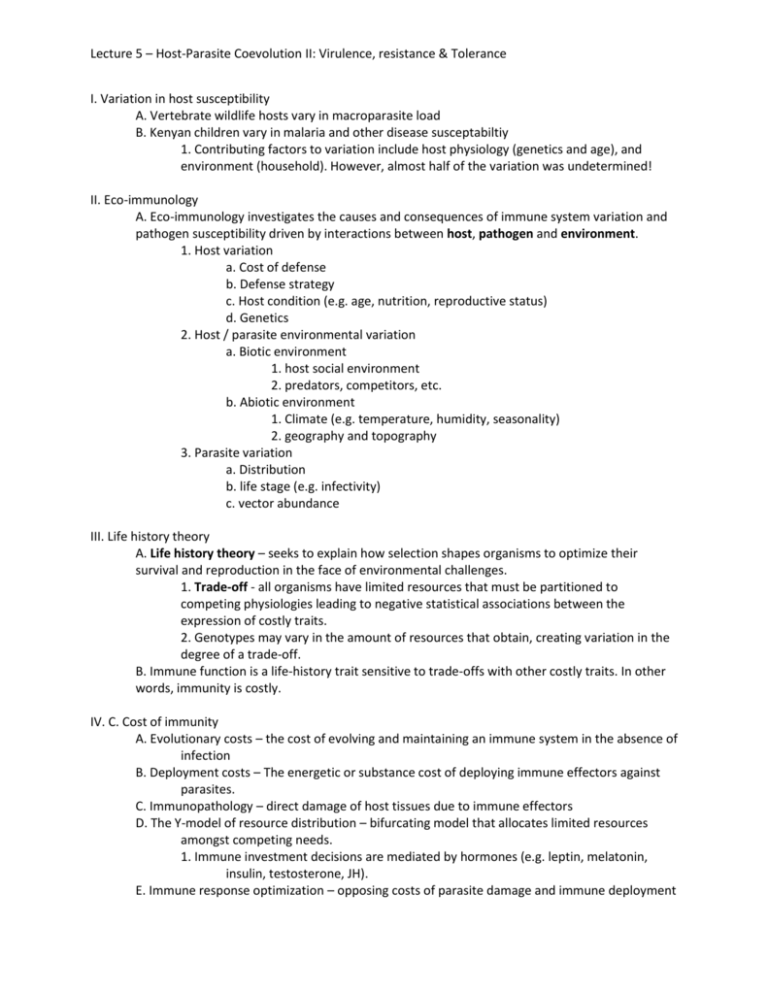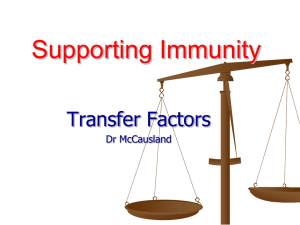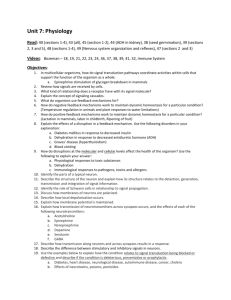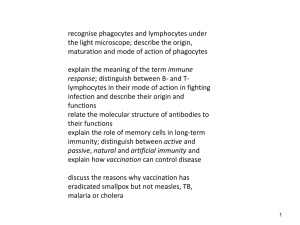L6-Ecoimmunology
advertisement

Lecture 5 – Host-Parasite Coevolution II: Virulence, resistance & Tolerance I. Variation in host susceptibility A. Vertebrate wildlife hosts vary in macroparasite load B. Kenyan children vary in malaria and other disease susceptabiltiy 1. Contributing factors to variation include host physiology (genetics and age), and environment (household). However, almost half of the variation was undetermined! II. Eco-immunology A. Eco-immunology investigates the causes and consequences of immune system variation and pathogen susceptibility driven by interactions between host, pathogen and environment. 1. Host variation a. Cost of defense b. Defense strategy c. Host condition (e.g. age, nutrition, reproductive status) d. Genetics 2. Host / parasite environmental variation a. Biotic environment 1. host social environment 2. predators, competitors, etc. b. Abiotic environment 1. Climate (e.g. temperature, humidity, seasonality) 2. geography and topography 3. Parasite variation a. Distribution b. life stage (e.g. infectivity) c. vector abundance III. Life history theory A. Life history theory – seeks to explain how selection shapes organisms to optimize their survival and reproduction in the face of environmental challenges. 1. Trade-off - all organisms have limited resources that must be partitioned to competing physiologies leading to negative statistical associations between the expression of costly traits. 2. Genotypes may vary in the amount of resources that obtain, creating variation in the degree of a trade-off. B. Immune function is a life-history trait sensitive to trade-offs with other costly traits. In other words, immunity is costly. IV. C. Cost of immunity A. Evolutionary costs – the cost of evolving and maintaining an immune system in the absence of infection B. Deployment costs – The energetic or substance cost of deploying immune effectors against parasites. C. Immunopathology – direct damage of host tissues due to immune effectors D. The Y-model of resource distribution – bifurcating model that allocates limited resources amongst competing needs. 1. Immune investment decisions are mediated by hormones (e.g. leptin, melatonin, insulin, testosterone, JH). E. Immune response optimization – opposing costs of parasite damage and immune deployment Lecture 5 – Host-Parasite Coevolution II: Virulence, resistance & Tolerance optimize the immune response. V. Immune Defense strategy A. Host residual reproductive value (i.e. the amount of reproductive potential left in a host) can influence host immune response and pathogen load. 1. Upon infection hosts can either decelerate or accelerate their investment in reproduction in order to maximize fitness. B. Host tolerance versus resistance – some hosts may opt to tolerate a pathogen instead of completely clearing the pathogen 1. resistance – genetic ability to clear a pathogen (i.e. sterilize) 2. tolerance – genetic ability to minimize infection costs a. Costs: trade-off costs (e.g. energy), parasite costs (e.g. toxins or tissue damage) and immunopathology costs (e.g. excessive antioxidants) C. Degree of immune response – hosts may exhibit a muted immune response and allow the parasite to persist in low numbers. This may allow the host to maximize fitness if time is fleeting. VI. Social environment A. Density dependent prophylaxis – immune investment is positively correlated with host density. This is expected when disease transmission is positively correlated with host density. B. Selfish herd – reducing parasitism risk in large aggregations by spreading it to your neighbors. This is expected when disease transmission is NOT correlated with host density. VII. Climate A. Vertebrates exhibit increased immune function during winter, but decreased in summer. Why? 1. Immuno-enhancement hypothesis – animals offset winter environmental stress by investing in cellular processes that promote survival (e.g. immunity) 2. Trade-off hypothesis – summer reproduction is costly, extracting resources from cellular processes that enhance survival (e.g. immunity) B. Invertebrates also exhibit seasonal immune fluctuations, but do not span multiple seasons. Why? 1. Temperature dependent immune investment hypothesis – investment in thermoregulation infrastructure causes an unintended increase in immune function C. Latitudinal / altitudinal clines 1. As organisms move towards the poles (or up mountains), climate shifts, driving diverse patterns in immune function. VIII. Geography








